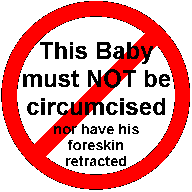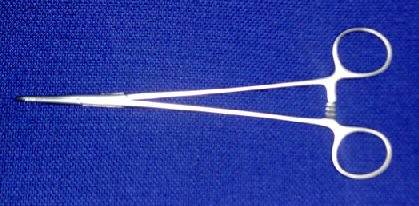| |
Phimosis and
Forcible Retraction
|
Messing with the foreskin of a child is like
messing with the closed eyes of new-born kittens; it just causes pain,
injury, and problems.
Walabio at YouTube,
October 14, 2008
|
The pseudo-diagnosis of "phimosis" (muzzling)
is often used as an excuse to circumcise a child or adult. Phimosis is
generally defined as the inability to retract the foreskin behind the glans. At birth the
foreskin is usually (but not always) fully attached to the glans, and
can not retract at all. For that reason:
|
Do
not retract your son's foreskin
or allow anyone else
- doctor, nurse, grandparent or babysitter -
to retract it.
He will retract it himself in his own good time.
When he does is the time to teach him to wash underneath it.
You can download a sheet of stickers with this
message in Word (*.doc) format
or in .pdf format
(which requires Adobe
Acrobat Reader ) (with a circumcision refusal form):
 
|
Incidence:
|
The Finnish National Board of Health provided
national case records for the year 1970 for both phimosis and
paraphimosis. A total of 409 cases was reported for males 15 years and
older,which represents only 2/100ths of 1% (0.023%) of the total male
population in that age group. [In
other words, less than 3 in 10,000.] This means
that 99.97% did NOT develop a problem. Moreover, according to Finnish
authorities, only a fraction of the reported cases required surgery - a
number too small to reliably estimate.
Edward Wallerstein, Circumcision:
An American Health Fallacy p.128
|
Age
The age at which it "ought" to be able to retract is
contentious. Certainly far too many "authorities" have defined such an
age based on nothing other than their own prejudice, usually much
earlier than the statistical average, one
"authority" even saying it must be retractable by the end of
the first week of life! Forcing it before it has detached creates a
wound that unites the foreskin and glans in a so-called "adhesion" (that the
forcing itself was intended to correct). The damage this causes is then
often used as an excuse to circumcise.
The inside of a non-retractable foreskin can easily be
cleaned by sluicing with water or squeezing the opening shut during
urination and allowing it to "balloon". "Ballooning" in
childhood is normal, and harmless unless it causes pain.
So at what age should it retract?
The anecdotal evidence is that the foreskin can almost always move
freely behind the glans by puberty. (When the first retraction
coincides with the first adolescent erection, it's a memorable
experience!) But a significant number of men never
experience full retraction, and have no complaints. One has sent his
story with pictures. A Hungarian porn "actor"'s foreskin never
retracts. They are shown here.
Be advised:
The educational pages within contain
close-up pictures of erect penises.
By entering, you acknowledge that
this is what you want to see.
ALTERNATIVES
Topical steroid
In Mumbai, India, Reddy
et al. found "Local steroid therapy
is safe and successful in alleviating symptomatic tight foreskin in a
large majority of children."
The Beauge Method
Dr Michael Beauge found that when adolescents presented
with phimosis (unable to retract a separated foreskin), they had been
in the habit of masturbating (if at all) by some other method than
pulling the foreskin back. His
treatment involves learning to masturbate in the conventional
way, which by itself encourages lateral tissue growth of the foreskin.
Dr Beauge has treated hundreds of young men successfully this way.
|
Dr Mark Reiss of Doctors Opposing Circumcision
reports:
In August of 2007 I got a phone call and several
emails from a distraught young man in his 20s, in which he complained
of phimosis, the degree of
which was affecting his ability to have and maintain an erection and
causing embarrassment in his sex life. He seemed to be profoundly
depressed. Of course all the urologists he saw recommended
circumcision,
but he wisely contacted a number of us, who recommended Dr.
Michael
Beauge's stretching technique:
I just got the following email from him, which is
very gratifying. I recommend that his experience be cited for similar
situations.
Hello, Dr. Reiss
I am the young man who contacted you over a year
ago about having
phimosis.
The study I read about Dr. Michel Beauge was
incredible and very
profound. Especially his analysis on certain conservative cultural
tendencies toward self-stimulation.
The method that Dr. Beauge implies in his paper
worked wonderfully for
me.
I was relieved 110% [sic] of my phimosis and it is
absolutely incredible. My
personal life has improved dramatically.
My stance against pre-emptive non-therapeutic
circumcision has become
more solidified after having applied the Beauge method.
I just wanted to let you know that anyone who has
phimosis should definetely try the Beauge method.
|
A young man has posted on Vimeo (after YouTube removed
it) "A Field Guide for the Modern [Intact] Male", an artistic version
of how
he successfully eased his foreskin back.
Do-It-Yourself Devices
A mechanical retractor, "the Glansie",
is designed for self-treatment of phimosis.

This has had at least one negative
review.
An Australian-made device, the
Novoglan GFS (Gentle Foreskin Stretcher), involves a tiny
balloon that is inflated within the foreskin. It costs $Aust108 (inc
GST).
This has has at least one negative
review.
The Phimocure is a series of five
silicone rings, 18 - 26mm in diameter, each successively larger size to
be worn for a week to hold the foreskin open.
A navy
surgeon successfully used small artery forceps for 2-3
minutes a day for two weeks.

Surgery
Kaye et al.
describe how skin-grafting is successful where phimosis is combined
with frenulum breve. Foreskin resection ("circumcision") is very rarely needed:
Pediatrics
May 2016
Foreskin Morbidity in Uncircumcised Males [who else?]Ida Sneppen, Jørgen Thorup
Abstract
OBJECTIVE: As a consequence of the discussion on whether the
health benefits of newborn male circumcision outweigh the risks and the
discrepancies in reported figures of complications, we evaluated the
incidence and morbidity of foreskin surgery due to medical indications
in boys from the Capital Region of Denmark in 2014.
METHODS: Medical records from all boys operated on the foreskin
due to medical reasons in the Capital Region in 2014 were reviewed.
Patients with hypospadias, ritual circumcision, and redo-surgery
because of complications to nontherapeutic circumcision were excluded.
RESULTS: A total of 181 patients were included. The cumulative risk of undergoing [any] foreskin operation before 18 years of age was 1.7% [one in 59]. Forty patients had histologic verified balanitis xerotica obliterans (BXO) corresponding to a total risk of 0.37% [one in 270] of
developing BXO. Mean age at surgery was 10.1 years (range 1–17).
Phimosis was the most frequently reported indication (95.0%). The
remaining 5.0% underwent surgery because of frenulum breve causing
problems during erection. Before surgery, 27.1% had foreskin-related
voiding problems and 17.1% had at least 1 episode of balanitis.
Circumcision was initially performed in 44 cases. The remaining 137
patients had a foreskin-preserving operation performed. Nine boys had
secondary circumcision after initially having foreskin-preserving
operation. [A total of 53 "circumcisions" performed, making the risk of that 53/181 x 1.7% or one in 201]
Fifty patients initially had preputial histology performed. BXO
was verified in 37 patients. Of the 9 patients with redo-surgery due to
recurrent phimosis, a further 3 had histologically verified BXO.
CONCLUSIONS: Childhood foreskin-related problems in a region
with no tradition of newborn male circumcision should not be neglected.
[The real conclusion: Childhood
foreskin-related problems are so rare, the likelihood of needing infant
male genital cutting ("circumcision") is negligible.]
|
Related pages:
|
|



